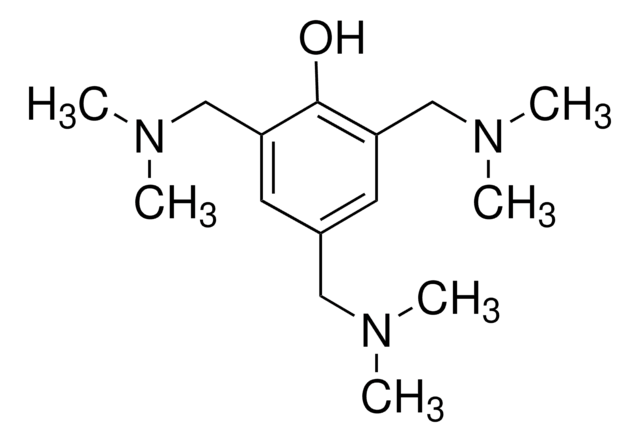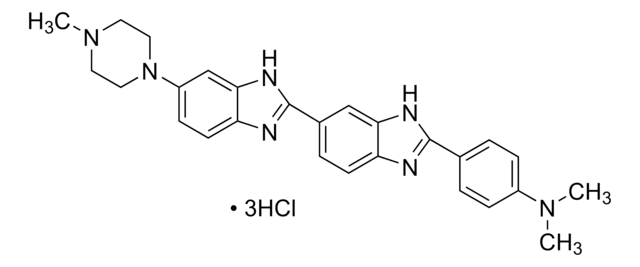D9542
DAPI
for nucleic acid staining
Synonym(e):
4′,6-Diamidin-2-phenylindol -dihydrochlorid, 2-(4-Amidinophenyl)-6-indolcarbamidin -dihydrochlorid, DAPI -dihydrochlorid
About This Item
Empfohlene Produkte
Qualität
for molecular biology
Qualitätsniveau
Assay
≥98% (HPLC)
Form
powder
Methode(n)
transfection: suitable
Löslichkeit
H2O: 20 mg/mL
PBS: insoluble
ε (Extinktionskoeffizient)
30 at 263 nm in H2O at 1 mM
Fluoreszenz
λex 340 nm; λem 488 nm (nur DAPI)
λex 364 nm; λem 454 nm (DAPI-DNA-Komplex)
Eignung
suitable for fluorescence
Lagertemp.
2-8°C
SMILES String
Cl.Cl.NC(=N)c1ccc(cc1)-c2cc3ccc(cc3[nH]2)C(N)=N
InChI
1S/C16H15N5.2ClH/c17-15(18)10-3-1-9(2-4-10)13-7-11-5-6-12(16(19)20)8-14(11)21-13;;/h1-8,21H,(H3,17,18)(H3,19,20);2*1H
InChIKey
FPNZBYLXNYPRLR-UHFFFAOYSA-N
Suchen Sie nach ähnlichen Produkten? Aufrufen Leitfaden zum Produktvergleich
Verwandte Kategorien
Allgemeine Beschreibung
Anwendung
- DNA-Färbung in Agarosegelen
- Analyse von DNA-Veränderungen während der Apoptose
- Nachweis von Mykoplasmen
- Photo-Footprinting von DNA
- Immunfluoreszenzfärbung von Zellen
DAPI wird verwendet:
- zur schnellen Überwachung von mikrobiologischen Kontaminationen
- bei der Chromosomenbänderungstechnik
- zum Nachweis von apoptotischen Zellen
- bei der Fluoreszenzmikroskopie zum Nachverfolgen der DisA (DNA-Integritäts-Scan-Protein)-Bewegung auf Bacillus subtilis-DNA
- zum Färben von ausgereiften Pollenkörnern (0,5 mg/ml)
Biochem./physiol. Wirkung
Vorsicht
Ähnliches Produkt
Signalwort
Warning
H-Sätze
Gefahreneinstufungen
Skin Irrit. 2 - Skin Sens. 1A - STOT SE 3
Zielorgane
Respiratory system
Lagerklassenschlüssel
11 - Combustible Solids
WGK
WGK 3
Flammpunkt (°F)
Not applicable
Flammpunkt (°C)
Not applicable
Persönliche Schutzausrüstung
Eyeshields, Gloves, type N95 (US)
Analysenzertifikate (COA)
Suchen Sie nach Analysenzertifikate (COA), indem Sie die Lot-/Chargennummer des Produkts eingeben. Lot- und Chargennummern sind auf dem Produktetikett hinter den Wörtern ‘Lot’ oder ‘Batch’ (Lot oder Charge) zu finden.
Besitzen Sie dieses Produkt bereits?
In der Dokumentenbibliothek finden Sie die Dokumentation zu den Produkten, die Sie kürzlich erworben haben.
Kunden haben sich ebenfalls angesehen
Artikel
Regulation of the cell cycle involves processes crucial to the survival of a cell, including the detection and repair of genetic damage as well as the prevention of uncontrolled cell division associated with cancer. The cell cycle is a four-stage process in which the cell 1) increases in size (G1-stage), 2) copies its DNA (synthesis, S-stage), 3) prepares to divide (G2-stage), and 4) divides (mitosis, M-stage). Due to their anionic nature, nucleoside triphosphates (NTPs), the building blocks of both RNA and DNA, do not permeate cell membranes.
The Comet Assay, also called single cell gel electrophoresis (SCGE), is a sensitive and rapid technique for quantifying and analyzing DNA damage in individual cells.
Verfügbare Verfahren zur Fluoreszenz-in-situ-Hybridisierung (FISH), Reagenzien und Ausstattung.
Available Fluorescent in situ hybridization (FISH) procedures, reagents and equipment.
Protokolle
Immunocytochemistry (ICC) Cell Capture Imaging Reagent and protocol for eliminating wash steps, and is highly effective in applications involving rare cells, low cell count samples, and limited access samples.
The Comet Assay, also called single cell gel electrophoresis (SCGE), is a sensitive and rapid technique for quantifying and analyzing DNA damage in individual cells.
Verwandter Inhalt
Three-dimensional (3D) printing of biological tissue is rapidly becoming an integral part of tissue engineering.
Unser Team von Wissenschaftlern verfügt über Erfahrung in allen Forschungsbereichen einschließlich Life Science, Materialwissenschaften, chemischer Synthese, Chromatographie, Analytik und vielen mehr..
Setzen Sie sich mit dem technischen Dienst in Verbindung.












